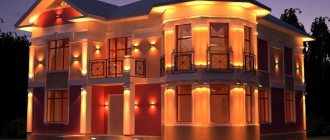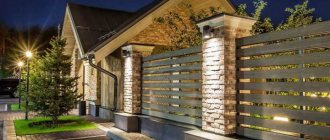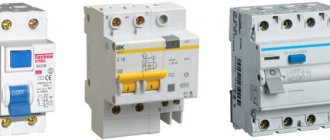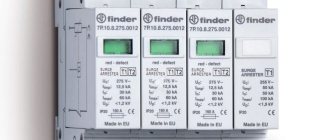Lighting in a private house differs from that in an apartment, since here you have to independently determine the location of the devices, lay the cable and carry out other mandatory work. If standard solutions are used in apartment buildings, then in the private sector any option that meets safety standards can be implemented.
Lighting in the home should be comfortable and safe.
How to plan lighting for a private home
You cannot work without a clear plan, so first of all you need to draw up a detailed project. This is a mandatory requirement of SNiP and PUE, it cannot be violated. When planning, you need to consider several recommendations:
- The project must be drawn up in accordance with established requirements, so it is better to entrust the work to specialists. Most often, this is done by the same organization that does the house project.
- To eliminate problems, you need to think through all the important points in advance: the location of equipment in the premises, the number of sockets and switches. It is also important to provide all lighting equipment.
- To simplify the process, you can use standard designs if the layout of the house allows it. They make planning much easier and cheaper.
- The method of laying the wiring and the location of distribution boxes is being thought through.
- The finished project must be approved by the supervisory organization. Without this, installation work cannot begin.
- When developing a project, it is necessary to determine the location of the power cable entry into the house, the location of the meter and the distribution panel.
An example of a lighting project in a small house.
If alternative energy sources are used - solar panels or a generator, then they must also be included in the project. If such decisions are made later, it is worth including them in the project and agreeing on it, so that no problems arise and you do not have to pay a fine.
Decorative light
As for the scheme for illuminating the interior space of houses with decorative light, it carries not only the function of lighting a room.
Using lighting, you can focus maximum attention on interior elements. Decorative lighting will make the space unique and add variety to the landscaping. The purpose of decorative light is local.
Types of lighting for different rooms
Lighting in a private house inside can be of two types - natural and artificial. The first option depends on the size of the window openings, their location relative to the cardinal points and weather. The second one is much more important, since with its help you can properly illuminate the house at any time of the day.
Types of lighting and their features
There are several options, differing in purpose and equipment used. Therefore, you need to understand each one in order to ensure comfortable light in the house:
- General lighting . Most often this is one or more chandeliers with several shades. Placed in the middle to evenly illuminate the room. Instead of the classic version, light panels or spotlights can be used, located in large numbers on the ceiling.
- Local lighting . It is necessary in order to highlight separate zones or provide comfortable conditions for work, needlework, eating, etc. In this case, built-in, overhead, wall lamps are used. Portable options are also suitable - floor lamps, table lamps, etc.
- Decorative lighting . Needed to decorate a room and highlight individual elements. You can use this option to illuminate niches and the contours of the room. Modern solutions are especially widely used here - LED strips, compact directional light fixtures, etc.
All types of lighting can be used in one room.
Sources of light
In order for the light to be of high quality and provide comfortable conditions, you need to make the right choice:
- Incandescent lamps are cheap, but not very high quality. They do not last long, give only yellow light and get very hot during operation. They consume the most electricity.
- Halogen options are an order of magnitude better, as they provide light close to daylight. But at the same time, they also consume a lot of electricity, get very hot and do not last very long.
- Fluorescent ones are much more economical, provide bright light and do not get hot during operation. But in this case, flickering may be observed, and mercury vapor is used inside, which is dangerous if the flask is damaged.
- LED lamps are the best solution, characterized by efficiency, a service life of 50,000 hours and low heating. The quality of light is the highest.
LED equipment consumes minimal electricity.
When using different light sources in a room, it is better to select lamps with the same color temperature.
Electrical supply to the distribution panel
The electrical network in any private home begins with the power input. The power input can be from the electrical network, a diesel generator, a wind generator or from solar panels.
And although only the first option is mandatory, independent sources of energy supply are increasingly used in our country. Therefore, in our article we will consider them too.
Connecting the house to the general electrical network
First of all, we will consider the option of connecting a private house to a public electrical network. The PUE standards require two connection options - an underground cable line and an overhead line.
Since it is simply not possible to obtain a connection to the electrical network without permits from energy regulatory authorities, you have to accept their conditions. And in almost 100% of cases they require connection using an overhead line.
Connecting a private house from an overhead line
So:
- An overhead line connection is now in most cases made using SIP wire . The main feature of this wire is the insulation of phase, and for some models, neutral conductors. This allows for more comfortable installation and also improves the appearance of the power supply network.
- If the distance from the nearest electrical pole to your home is more than 10 meters, then you will need to install an additional pole. At the same time, its height must be sufficient to ensure a distance from the ground to the wire of at least 6 meters if the wire passes over the road.
- In accordance with clause 2.1.79 of the PUE, the wires must be inserted into the house at a height of at least 2.75 meters . In this case, the distance from the supporting insulators to the wall, as well as from the wires to other elements of the building, must be at least 20 cm.
- The passage of the wire through the wall of the house in accordance with clause 2.1.78 of the PUE must be carried out using pipes or metal corrugation . At the same time, their design must exclude the possibility of ingress and accumulation of moisture inside the pipe.
- If your meter is installed on the facade of the house, and the cable from the input goes down to it along the wall , then you should provide protection for the cable from mechanical damage. For brick houses it can be plastic corrugation, but if it is lighting in a wooden house, then it should be a metal pipe or corrugation.
Connecting autonomous power supplies to the electrical network
As for autonomous power supplies, they differ quite strikingly for different types of these devices. And they largely depend on the way you work.
For example, if a diesel generator must be connected to the network only after the main network voltage disappears, then other types of autonomous power supply can operate in parallel with it.
Connecting a generator to power a private home
So:
- Instructions for connecting diesel, gasoline or gas generators usually assume their operation as an emergency source of power supply. In this regard, they must be put into operation when the voltage disappears. The connection diagram also depends on this.
- Typically, a lighting network AVR cabinet is used for connection. The essence of this cabinet comes down to installing two starters. One of them is supplied with power from the electrical network, and the other from a diesel generator.
- If there is voltage in the electrical network, one starter will be pulled up. When the voltage disappears, it disappears and the starter from the diesel generator turns on. Typically, in addition to the electrical one, these starters are also equipped with a mechanical interlock, which prevents one starter from being pulled up while the second starter is pulled up.
The photo shows an option for connecting solar panels to the house load
- As for wind and solar panels, to install them you will need quite expensive additional equipment - a battery and an inverter. In addition, the kit usually includes a cabinet for interaction with the electrical network.
- The fact is that these sources of electric current can operate either completely autonomously or in parallel with the general electrical network. The second option is more convenient and will allow you not only to consume, but also to generate electrical energy into the network. But the price of this option is naturally higher.
- Therefore, options for autonomous operation of such devices are often used. If the load is too large, or the batteries are discharged, then the electrical network is turned on. This parameter is usually controlled using a voltage relay, which, within certain limits, turns off the input of the autonomous power source and turns on the input of the general power supply.
Note! Some models of such autonomous power supplies contain additional current protection, temperature protection and similar automation equipment. This depends on the configuration and manufacturer of the power supplies.
Lighting control inside a country house
Current trends are such that more and more automation equipment is being used in homes. But traditional solutions are also in demand. You can control the light in different ways:
- Standard switches are the simplest solution. They come in different shapes and sizes.
- Motion and sound sensors turn on the equipment when a person enters the room.
- The control panel allows you to turn lights on and off and adjust their brightness from anywhere in the room.
- The smart home system helps control the light from a phone or computer, even if a person is not at home.
At the end of the video, which describes in detail the budget version of the lighting system (in your home)
When installing a lighting system in a house, you need to draw up a project, approve it and lay the wiring strictly according to the diagram. It is important to install the shields correctly, think through the lighting system and purchase high-quality and durable lamps.
Main light
Such lighting provides a flow of light evenly throughout the entire space and most often consists of certain groups, located, for example, at different levels of a plasterboard ceiling surface. Such an organization provides a unique opportunity to choose lighting exactly to suit your mood.
Author's solutions in the field of residential lighting
When designing artificial lighting systems, several diverse problems are solved. One of them is the placement of lighting fixtures in such a way as to highlight the original design elements of living rooms and services with maximum benefit.
To achieve these goals, different types of lighting devices and placement methods are used. Built-in luminaires with reflector lamps have become widespread.
Such devices provide a directed and focused stream of light, which will highlight a specific interior detail - a niche or bookshelf. There are a great variety of designs and design options for spotlights.
Their appearance is selected for each specific case and in accordance with the tastes of the home owner. The variety of forms provides wide scope for the realization of the author’s creative ideas.
Modern and cozy table lamps
Table lamps, our irreplaceable helpers at home and at work, of course, also do not stand aside from fashion trends. Our workplace should be not only functional, but also beautiful. Just as, in the words of aircraft designer Tupolev, “only beautiful airplanes can fly well,” one can only work well at a beautiful desk. And the table lamp, as its constant attribute, should look amazing not only when it’s on, but also when it’s off. Fashion dictates any of these for a table lamp, to choose from:
- natural motives;
- strict geometric outlines;
- presence of brass;
- spherical lampshades;
- white, black, terracotta colors.
Such lamps will not become outdated for a long time, you can rest assured, and, by the way, they will fit into any interior.
Color therapy
It is no secret that shade affects performance and mood; it is for this reason that color therapy is of great importance in modern design. At the same time, the combination of designer ideas and lighting in home decoration is limited solely by your decision.
However, there is no need to overdo it with the number of details or the palette of decorative lighting shades, otherwise you may end up with an uncomfortable space.
Facade
Mainly used for illumination of buildings and residential buildings. As a rule, they are installed on the facades of buildings.
External is divided into 3 main types:
- Facade lighting. It is used to illuminate large buildings and illuminates the entire building.
- Local lighting illuminates the most expressive parts of the house.
- Hidden lighting transforms buildings through built-in LED lamps inside the façade.
Floor lamps are used for lighting. They are lighting fixtures with frosted glass diffusers that fit perfectly into retro and high-tech styles. Floor lamps are installed vertically along garden paths.











